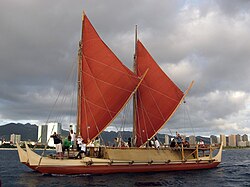
Burulan is a Visayan term referring to fighting platforms on the traditional large trimaran warships ( balangay ) of the Philippines. They were made from bamboo and were distinctively raised from the deck. They carried the warrior-nobility of the Visayans and other passengers during travel, naval warfare, and seasonal coastal raids ( mangayaw ), so as to avoid interfering with the paddlers. This platform can be covered by an awning of woven palm leaves (kayang, Spanish: cayanes) during hot days or when it rains, protecting the crew and cargo. [2] [3]
In very large ships, the burulan can be augmented by a pair of fighting platforms mounted directly on the cross-wise supports (batangan) of the outriggers (katig). These were known as pagguray. They differed from the daramba , which were also platforms mounted on the outriggers, in that the latter were mounted on the water and were used by commoner warriors ( horo-han ) primarily for paddling, and occasionally for fighting. [2] [3] [4] [5] [6]




